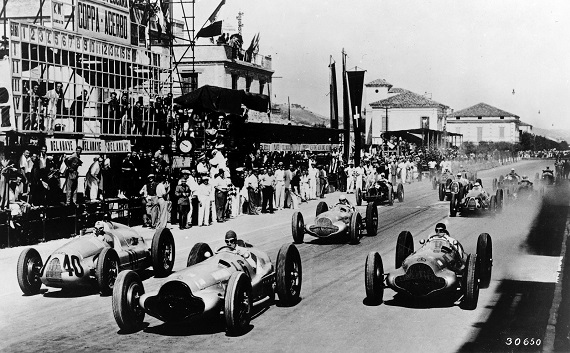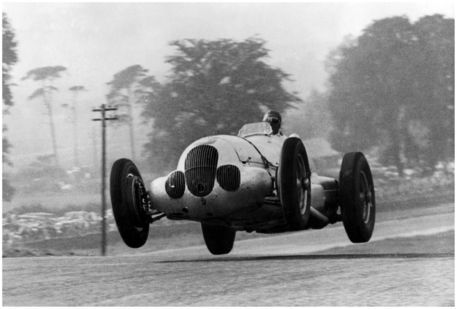
1938 Coppa Acerbo – Mercedes-Benz W154s and Auto Union Type Ds leave the starting line
We’re going to run something a bit special over the coming few weeks; a bit of a history lesson. In light of the 2014 championship for Mercedes-Benz in Formula 1, I wanted to revisit some research I did in 2003-2004 as part of a Master’s program at the University of Cambridge. We take it for granted that large corporate sponsors and major automobile manufacturers engage in motorsports as a natural outlet and expression of their engineering prowess in order to help sell brand identity, brand loyalty and ultimately sell more cars, trucks and motorcycles. Yet, there was a period where this was not a certainty – indeed, in the early 1920s it was still presumed that racing was an endeavor only rich gentlemen partook in, much like horse racing. But the combination of two companies competing against each other, a government eager to tout the superiority of its products, and new technologies all combined in a very special period during the early 1930s. The reign of the Silver Arrows was only halted by the outbreak of war, yet during that period of roughly 6 years we saw some of the fastest, most powerful and most exotic designs be innovated by the two German marques that the world has ever witnessed. The Mercedes-Benz W125 would remain the most powerful Grand Prix car for 50 years, until the 1980s turbo era, and properly streamlined, they still hold closed-course records in Germany at 270 m.p.h. on the public Autobahn. The spectacle held not only Germans attention, but all of Europe looked on as these two Goliaths tried to outsmart and outspend each other. Ultimately, they went to extremes to prove their dominance and win the favor of the German people – but more importantly, the German government, who by the late 1930s increasingly held the purse strings to valuable commodities needed for the production of automobiles. The following tells the tale of how the two German marques became involved in Grand Prix racing, how successful each was, and problems and challenges they faced along the way. It’s told from more of an economic standpoint, to help to explain why the two firms would race Grand Prix cars when neither offered a sports car for sale to the public. For the purposes of this blog, I’ve removed the citations and many of the quotations (most of which are in original German) as this is already quite long. I hope you all enjoy it, and if you have any specific questions please leave comments and I’ll do my best to answer them! Without further ado…






